As we head into the fall and winter months my chickens are laying eggs left and right. So much so, I have an overabundance of eggs piling up in my ‘egg-stra’ refrigerator.
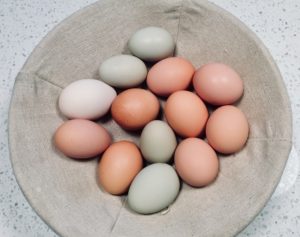
On average, I collect 10-12 eggs per day from the 13 hens currently laying. Four additional pullets have yet to produce but at 5 months of age, they should be laying any day now. Just in time for the older hens to slow down for the winter.
So, what do I do with all of these eggs? Beyond selling them or giving them away to close friends, I’ve had to get creative. Egg salad sandwiches, deviled eggs, scrambled eggs, over easy, sunny side up and baking them into breads, cookies, and cakes, just can’t keep up.
DONATE, GIVEAWAY, SELL
One fantastic idea is to donate them to a food bank or shelter. I’m uncertain what the regulations are for this but it may be worth doing some investigation. If you call your local food bank directly, they should be able to tell you or at least point you in the right direction.
Another way around funneling eggs through the local food bank is to use social media as a tool. For example, my area has a Facebook page that allows for-sale and free-for-giveaway items to be posted. Whether you choose to sell them or give them away, someone will be happy to get their hands on some farm fresh eggs.

Just keep in mind the current asking price in your area for fresh eggs. Egg prices can fluctuate depending on the season as many hens lay less during the winter months. In times of less product, prices increase and vice versa.
Also, know your state, city or county regulation in regards to selling fresh eggs. Do you need inspection and licensure? Do the eggs need to be washed? Do your eggs have to be kept at a certain temperature prior to the sale? All valid points to know before you make a transaction.
FEED SUPPLEMENTATION
Dogs & Cats
Think of eggs as high-protein feed, not just for your family but for your pets as well. We’ve all heard the story of the egg-sucking dog, so it’s easy to connect to the fact that dogs love eggs. In fact, my four-legged friends come running as soon as they hear me crack an egg on the side of a bowl!
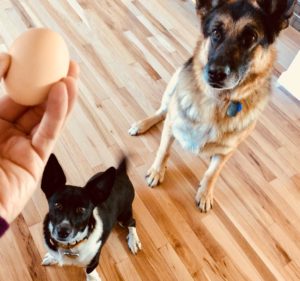
Supplementation of egg into your dog or cat’s diet is good for them. The yolk’s natural fats and cholesterol can do great things to keep their fur and skin healthy.
Raw or cooked eggs are equally as pleasing to your pooch. I would, however, recommend cooking them to ward off any possibility of salmonella. Whichever you choose, your dog or cat won’t mind what form you feed it.
Chickens & Other Poultry
When it comes to feeding eggs back to your chickens, the added egg protein can be a great boost to support feather replacement during molting. The only catch? Just make sure you cook the egg and present it in a different form. You won’t want your egg layers starting to peck at the eggs in their nesting boxes.
I’ve seen various forms of high-protein “egg loaf” or even meatloaf recipes that have been utilized to feed chickens. I take a simple approach and add what I generally have on hand. My recipe can be used for 6-12 eggs, just adjust the dry ingredients accordingly.
Not only will your birds benefit from the increased protein in their diet, YOU and THEY will also benefit in other ways. By leaving the shells in the following loaf recipe your chickens will receive added calcium while the oregano gives their immune system a little boost. For you, the flax meal is said to increase the omega-3 fatty acid content in the yolk…that makes for a super healthy egg!
25 Acre Egg Loaf
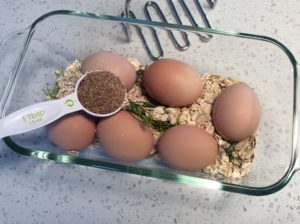
- 6-12 whole eggs
- 2-4 tsp oregano
- 2-4 sprigs of dill when available
- 2-4 handfuls of rolled oats
- 1-2 tbsp flax meal (or wheat germ)
Preheat oven to 350 degrees. Place all ingredients in a bread loaf pan, crush eggs into dry ingredients with a potato masher. Bake for 30-40 minutes or until the center of loaf is cooked. Remove from pan, cool and feed to your flock! This loaf can be sliced and frozen for treats when your birds molt or when egg-laying slows.
Feel free to omit or add other ingredients your chickens love. I try to focus on high protein additions such as mealworms, pre-cooked lentils and yes, bits of cooked chicken.
EGG BASED RECIPES
You can cook an egg as it is but you can also transform it using different ingredients and techniques. Various recipes can be found all over the Internet. From meringues to custards and even angel food cakes, you can easily find recipes to use up a larger volume of eggs. Even an egg yolk laden, custard-style ice cream can be a delightful way to use up your windfall of eggs.
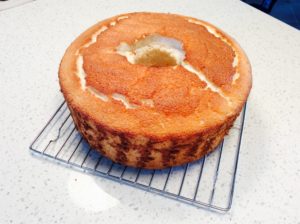
Get creative with a french toast bake for breakfast, using eggs as a binder in much the same manner as bread pudding. Maybe you are craving something a little less sweet but not a fan of quiche? Try this!
Sausage, Egg & Toast Bake
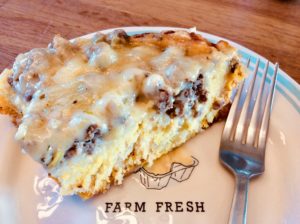
- 6 eggs
- 1/2 cup milk
- 6 slices of bread (or 3 prepared biscuits halved)
- 1 cup cooked sausage, ham or bacon
- 1 cup Cheddar Cheese
- Salt & pepper
- Diced onions & peppers (optional add-ins)
Preheat oven to 350 degrees. In a large bowl, rip bread into large pieces and combine with sausage, onions & peppers; layer into greased 8×8 Pyrex baking dish. Beat eggs & milk in a separate bowl and season with salt and pepper. Pour egg mixture evenly over the top of your bread and top with cheese. Bake for 30-40 minutes until egg is cooked.
In my most recent version of this recipe (pictured above) I used day-old biscuits sliced in half with 2 cups of hash browns as the base. Once the egg mixture was added, I then layered on peppered sausage gravy and pepper jack cheese. It was a hit with my husband!
STORING EGGS
It’s a well-known fact that refrigerated eggs last longer than those stored at room temperature. The same holds true for unwashed eggs over washed eggs. I have even read instances of oiling eggs to increase their edible lifespan.
If stored properly, eggs can last months before they spoil. As hens enter their winter slow down, this could work to your advantage if you stockpile eggs for personal use.
When in doubt about an egg’s freshness, you can always use the float test method. If it sinks to the bottom of a water-filled glass, it is fresh. If it floats slightly but remains under the surface of the water, the egg is aging but likely edible. However, if a floating egg rises to the surface, throw it out as it is likely bad.
PICKLED, FROZEN, DEHYDRATED
Of the three methods; pickled, frozen and dehydrated, I’ve only tried the first two. The method you intend to use boils down to the purpose in which you plan to use the egg.
Pickling
Pickling eggs will store a peeled, hard-boiled egg for a long period of time in the refrigerator. While the pickling liquid lends lots of flavor to the egg, the unfortunate side effect is a change in texture. Because I’m a real mouth-feel eater, this method is not my favorite. However, it doesn’t hurt to try something new when you have an abundance of eggs. After finishing your next batch of pickles, just save the brine and drop in a hard-boiled egg.
Freezing
Freezing cooked eggs also does crazy things to the overall texture. When I use this method of preserving it’s likely to keep egg loaf or scrambled eggs for my chickens. They don’t seem bothered by the texture change as they eagerly gobble up these treats during the winter.
Frozen raw egg, on the other hand, is an interesting one, but the process works quite well. Just place the well-beaten raw egg in a freezer-safe container or zip-seal freezer bag.
To thaw, allow the frozen egg to hang out in your refrigerator for a day or so. I found that thinner layers of frozen, beaten egg, thaw more consistently. You can even use this method by freezing the prepared egg in ice cube trays; 2-3 cubes equal 1 egg.
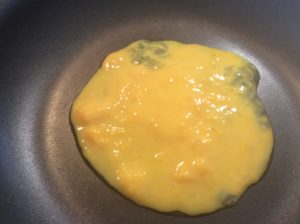
Once thawed, the consistency of the fatty yolk changes ever so slightly (see above). Simply beat the eggs again, then cook as normal. The mouthfeel is that of a fresh egg, so this is one preservation method I’d strongly recommend.
Dehydrating
Dehydrating raw egg is something I have not tried. I have read a few articles and watched more than my fair share of YouTube videos on it. The most attractive reason for using this means of preservation is the process reportedly doesn’t change the texture of the final cooked egg.
Essentially, you pop well scrambled, raw egg onto a dehydrator tray designed for liquids (fruit leather tray). Once dry, you process the flake into a powder for storage. No need to take up precious freezer space with this method. To rehydrate, just add 2 parts water to 1 part egg powder, prepare as usual.
Beyond the length of time required to dehydrate, the downside to this method is the risk of bacterial growth due to the raw egg. Various opinions and conflicts surround using this method, which I suppose is what has stopped me from trying it.
IN SUMMARY
Abundance can be a good thing when it comes to eggs. I just need to remind myself how fortunate I am to have the experience of raising such prolific egg layers.
For me, my grocery store is as close as my own backyard, fully stocked pantry or chest freezer. With a little forethought and planning, eggs can be stored and made available to me all year long.
As for times of surplus, well, I think it’s safe to say my friends, pets and the chickens are happy I share!













1 Comment
We have taken our excess eggs and donated to the local mission (usually a couple times a month)… We also have a great relationship with our local Wildlife Rehabilitation and Rescue. The baby racoons love our eggs…they also get some goodies when we butcher sheep.